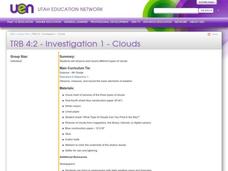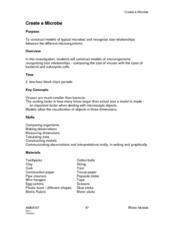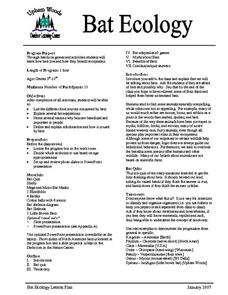Curated OER
Mini Water Cycle
In this water cycle learning exercise, students create a mini version of the water cycle in a plastic bag by observing the bag for 5 days. Each day students draw a picture of how their bag looks and write an explanation of what they...
Curated OER
3-D Magnetic Field
In this magnetism worksheet, students build a 3 dimensional magnetic field by using a juice bottle, a test tube, iron fillings and a magnet. Students write a descriptive story about what they observe once their bottle is complete and...
Curated OER
Oxidation: How Can It Be Proved?
Learners explore the process of oxidation. In this lesson about oxidation, students observe four different demonstrations. Learners watch examples of oxidation in order to understand the process. Students discuss the chemical reactions...
Curated OER
Planet Zorcon
Students relate the geography and economics of Utah. In this geography lesson, students log their use of resources both natural and synthetic. Students participate in an experiment to understand how the Earth will be in the future if our...
Curated OER
Second Servings
Second graders understand the appropriate sizes for food portions. In this food groups lesson plan, 2nd graders create and measure a meal using correct portion sizes and correct measurements.
Curated OER
Clouds
Second graders explain what a cloud is, how it is formed and what the various types of clouds are. They do an experiment which shows them how to "make" a cloud, and write in their science journals about a "crazy weather day."
Curated OER
1, 2, 3 Hooray for Number Equivalency!
Young scholars represent equivalent amounts using concrete materials, number symbols, and number words.
Curated OER
The Living Corn Necklace
Fifth graders generate two types of corn seeds, Dent corn and Indian corn to compare the similarities and differences of each of the seedlings. The preferred seedlings are determined through observations made by Students.
Curated OER
Pesticides
Learners investigate the uses of pesticides and the pros and cons of their use. In this pesticides lesson plan, students observe simulations of the three classes of pesticides and the effects or actions each has. Learners answer 3 follow...
Curated OER
Introduction to Organs/Organ Systems via Frog Dissection
Students are to create, in groups of four, the insides of a frog. This is in preparation for the frog dissection that will follow this introductory lesson. Students can begin predicting what the inside of the frog will look like prior to...
Curated OER
Clouds
Young scholars observe and record different types of clouds. They use a cloud chart to discuss the three cloud types to see if students can identify the clouds they drew.
Curated OER
Lesson Plan Seven: Sensorama
Students identify five senses, and use their senses of touch, sight, hearing, smell, and taste to distinguish different objects, sounds, smells and tastes, and write their answers in the booklet.
Curated OER
Beautiful Bugs
Students investigate the life cycle of ants, ladybugs, and butterflies. They list the four stages of the butterfly life cycle, define symmetry and observe how ants make homes in dirt.
Curated OER
Water Filtration Competition
Students design water filtration systems. They draw sketches and write paragraphs about their systems. After presenting their systems to the class, each group then builds their system and determines its effectiveness for purifying...
Curated OER
Create a Microbe
High schoolers construct models of microorganisms recognizing size relationships-comparing the size of viruses with the sizes of bacterial and eukaryotic cells. They put into perspective just how small microbes are by comparing the size...
Curated OER
The Water Cycle and Sources of Pollution
Young scholars make an island that has a construction site on it. They spill siulated pollution and trash on top of the island and then water it to simulate rain. They will observe how the rain washes dirt, sand, and pollution off the...
Curated OER
Cloud and Weather Patterns
Fourth graders examine how weather patterns generally move from west to east across the United States, and how clouds are formed and are related to the water cycle. They view and discuss a PowerPoint presentation of the types of clouds,...
Curated OER
Refrigeration Part 2 - How they work
Fourth graders investigate insulators and how refrigerators actually work to keep things cold through evaporation and pressure changes in the coolant. They create a box to keep an ice cube from melting, and observe a variety of...
Curated OER
Cloud in a bag
Students relate the states of matter and clouds. In this environment lesson, students create a chart of information they know about clouds. Students put an ice cube in a bag and tape to a window. Students watch for...
Curated OER
How Much Water?
Learners investigate amount of water available in different countries around the world, compare it to their daily water use, and explore how unequal distribution of water can cause challenges to survival. Students then discuss need to...
Curated OER
Not Just A Bag of Air
Fifth graders label the parts of the respiratory system. They distinguish among the functions of its major organs. They construct a model of the respiratory system. They watch an animated video and utilize the Internet for research of...
Curated OER
States of Matter
Fourth graders define the term matter. They compare properties of solids, liquids, and gases. They describe how matter changes from one state to another. They classify objects as either solid, liquid, or gas.
Curated OER
Bat Ecology
Students, through hands on games and activities, discover how bats live and how bats benefit ecosystems. They play a game designed to show them how echolocation works and another to show how mother bats locate their young through their...
Other popular searches
- Cotton Balls for Clouds
- Measuring Area Cotton Balls
- Smoking Cotton Balls
- Salt and Cotton Balls
- Food Web Cotton Balls
- Measring Area Cotton Balls
- Meas Ring Area Cotton Balls























